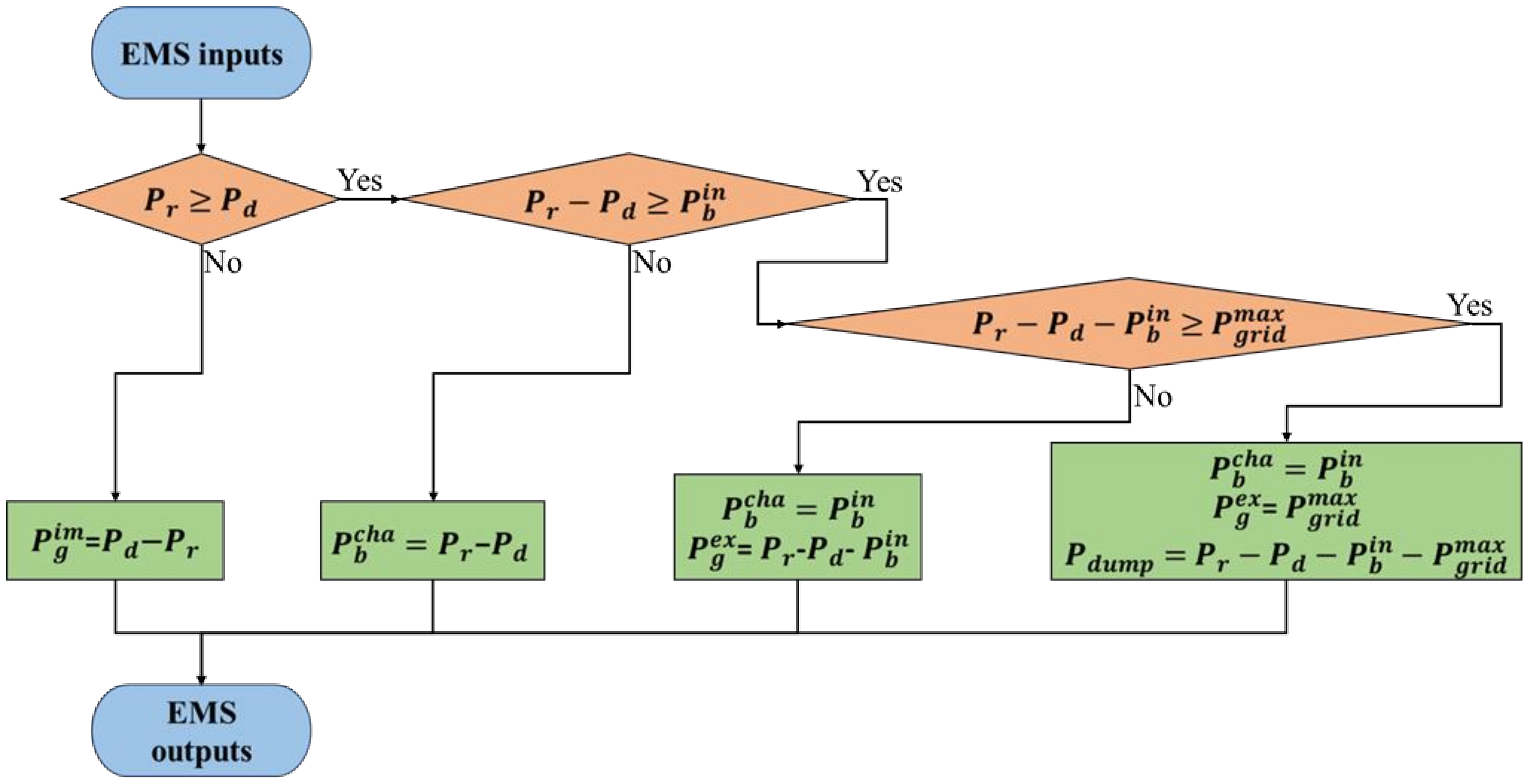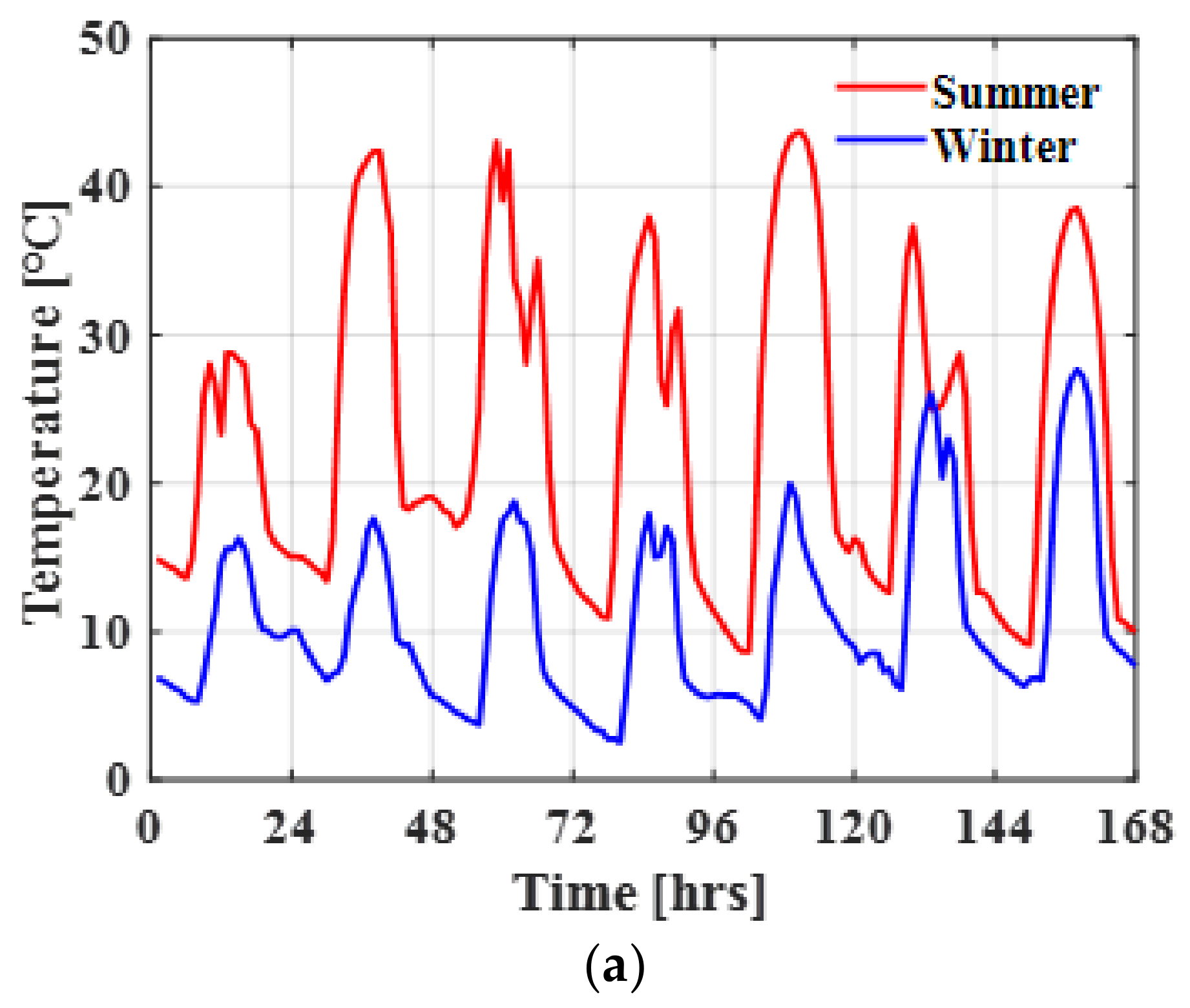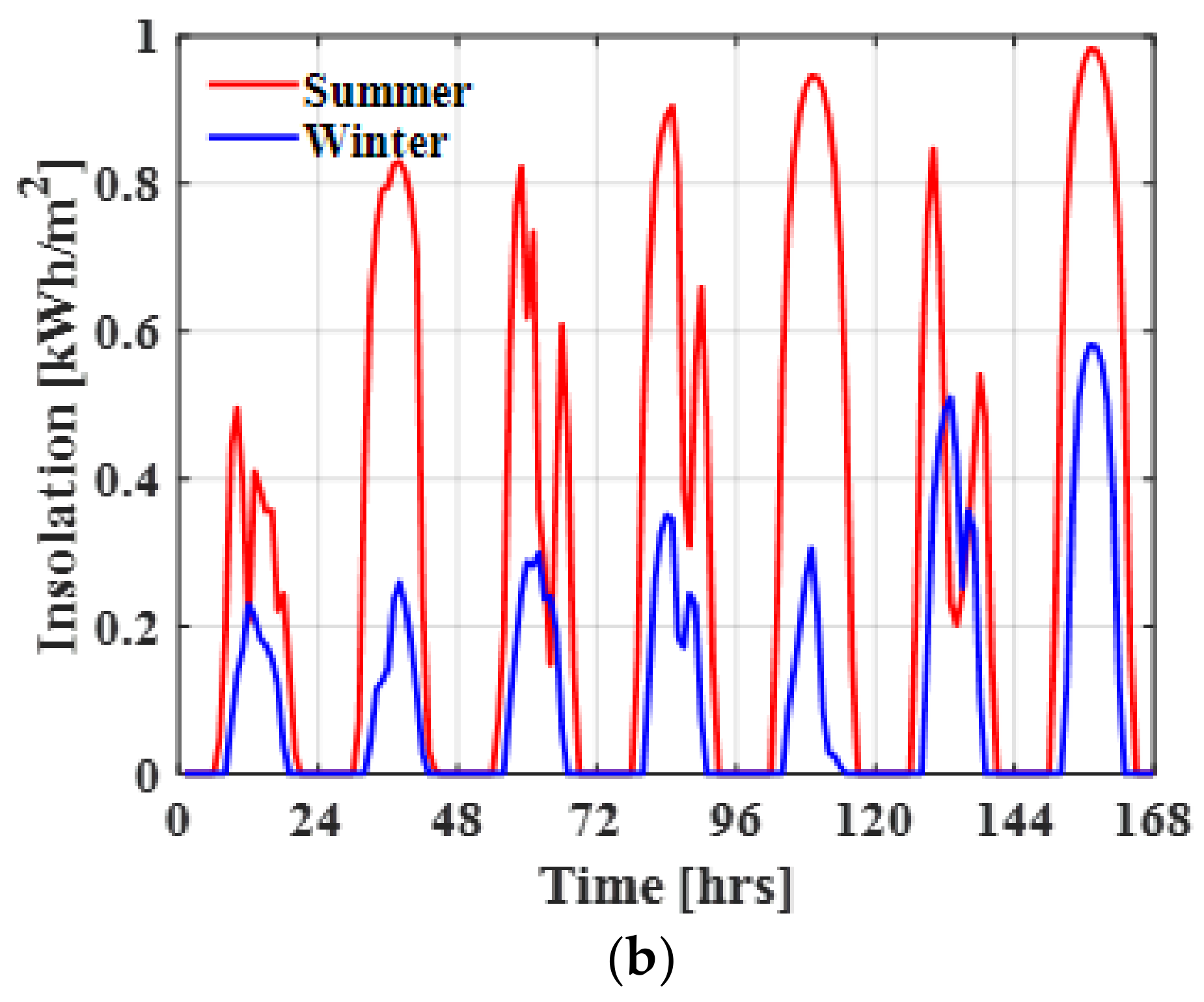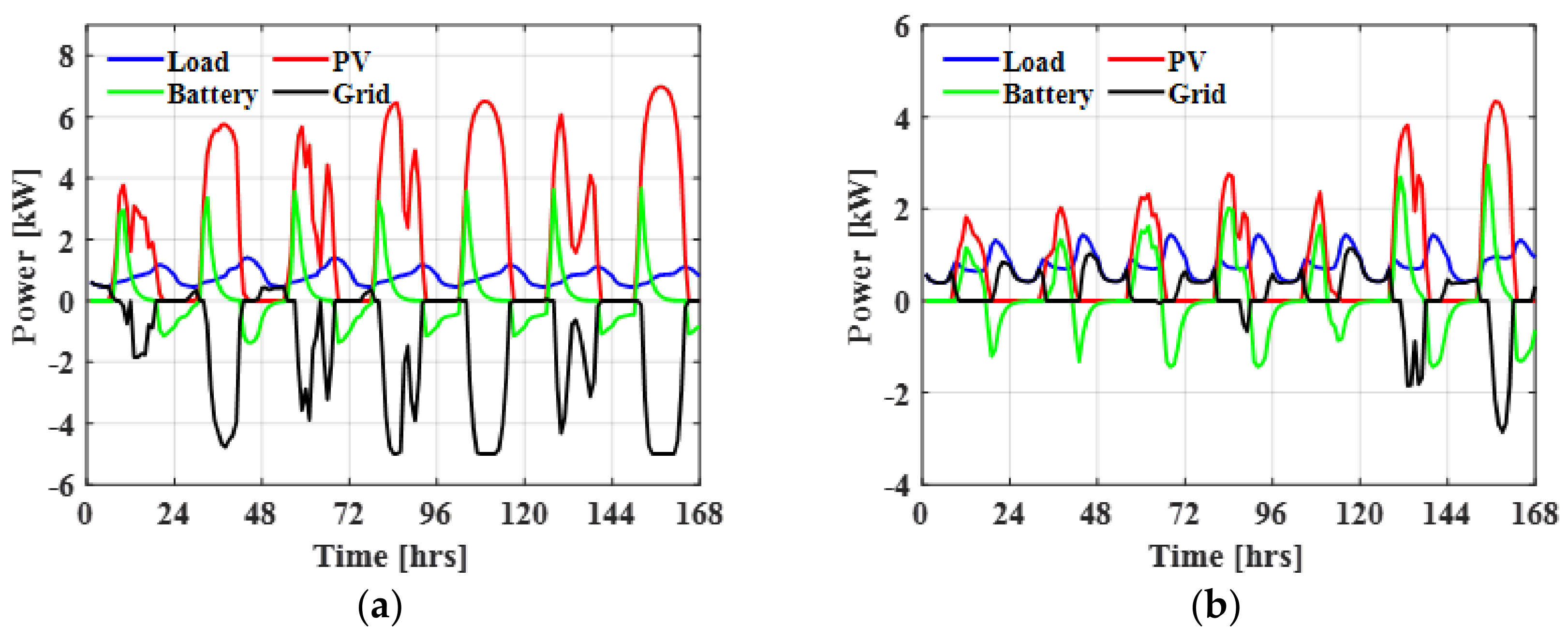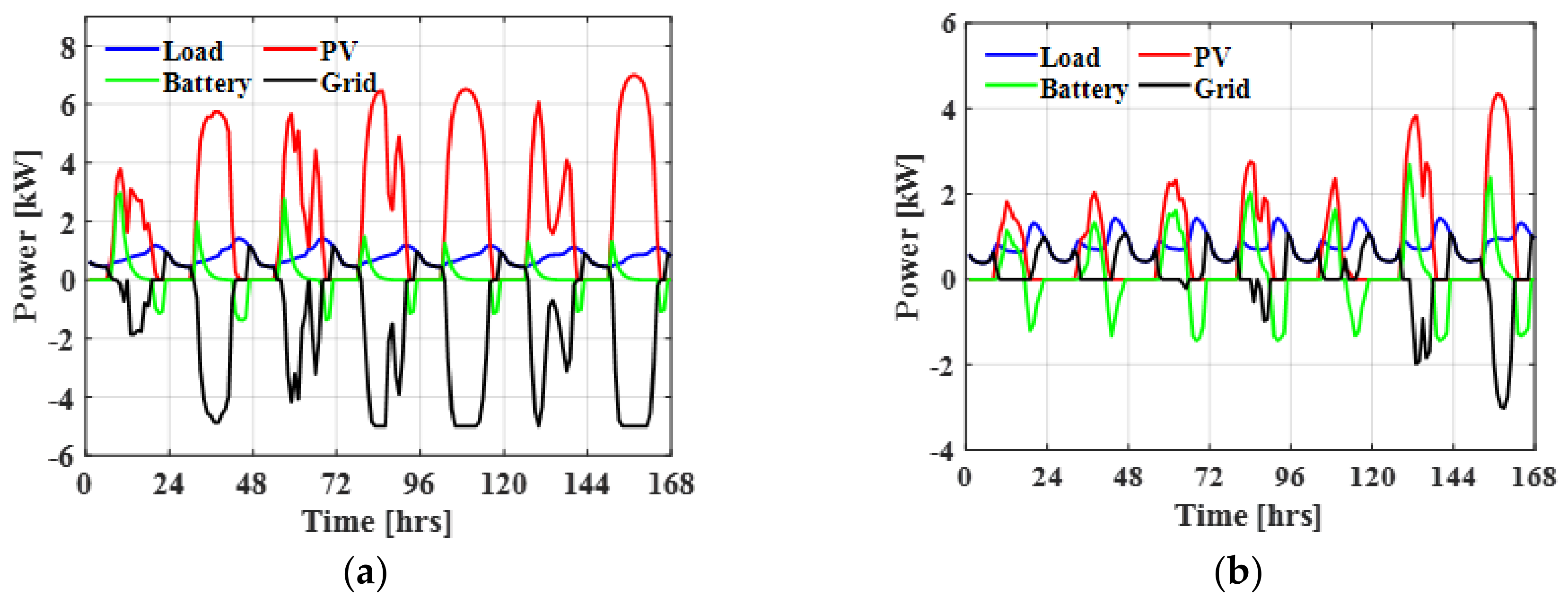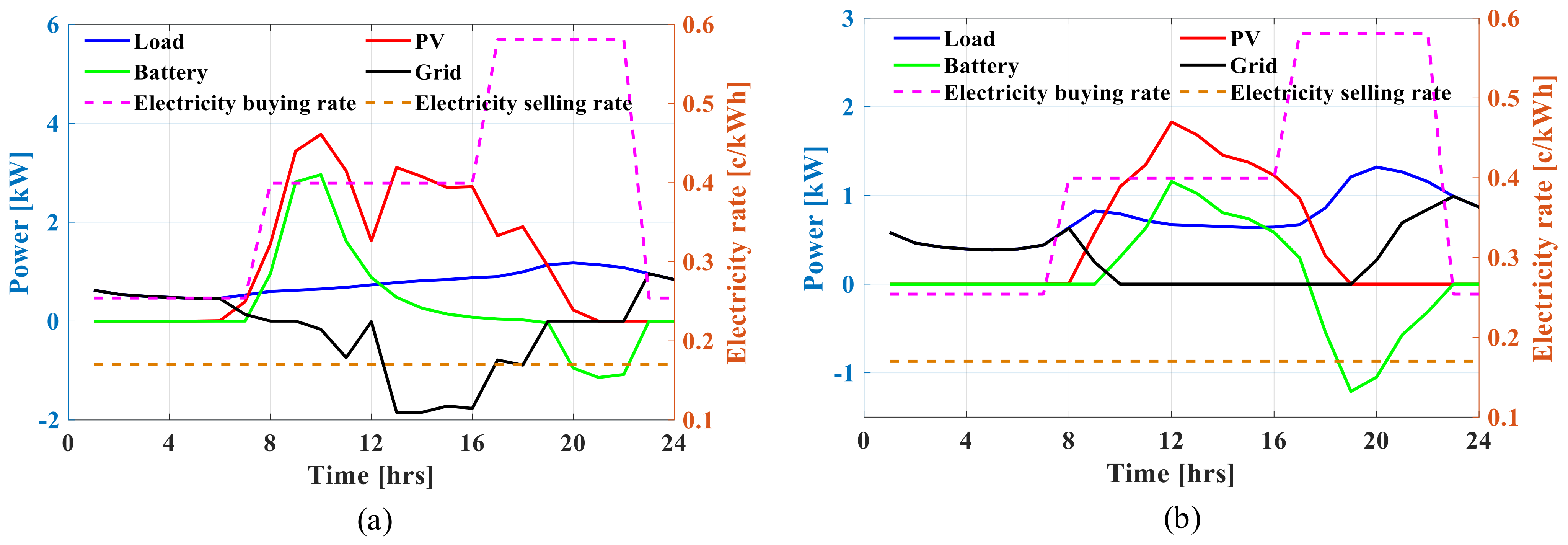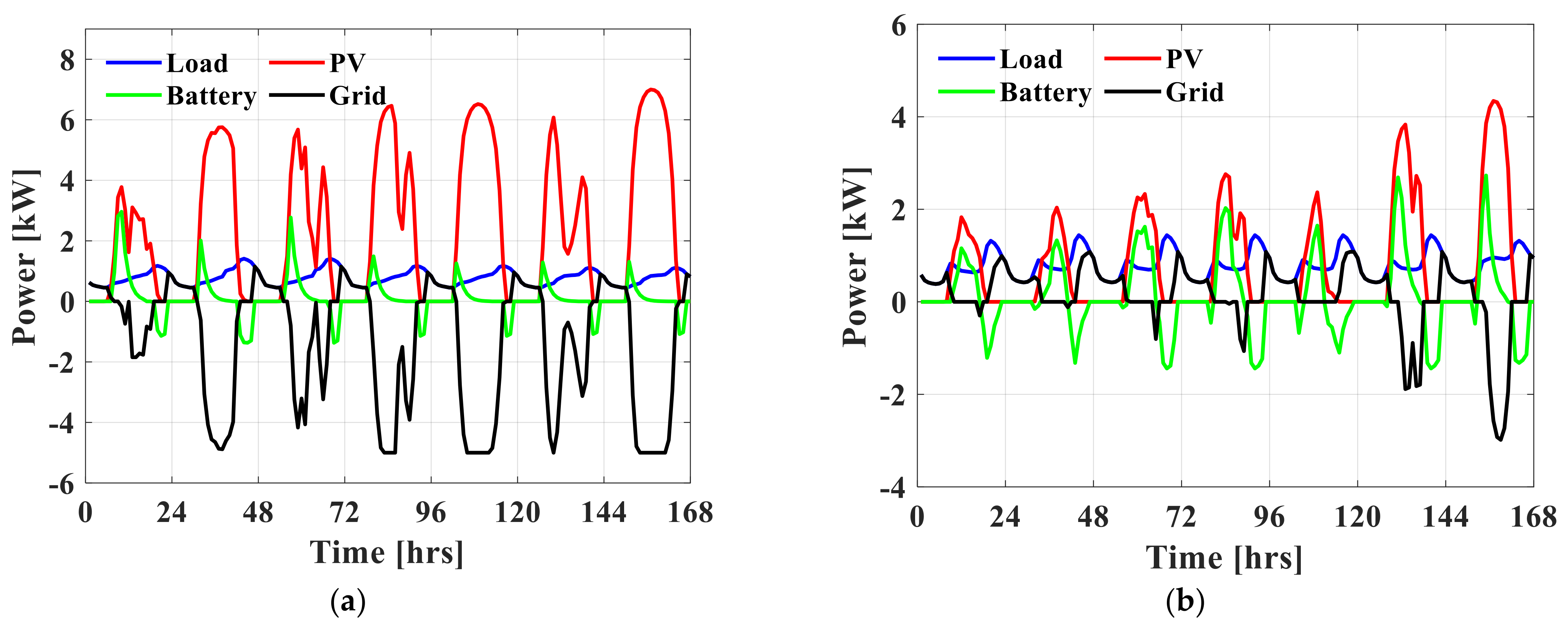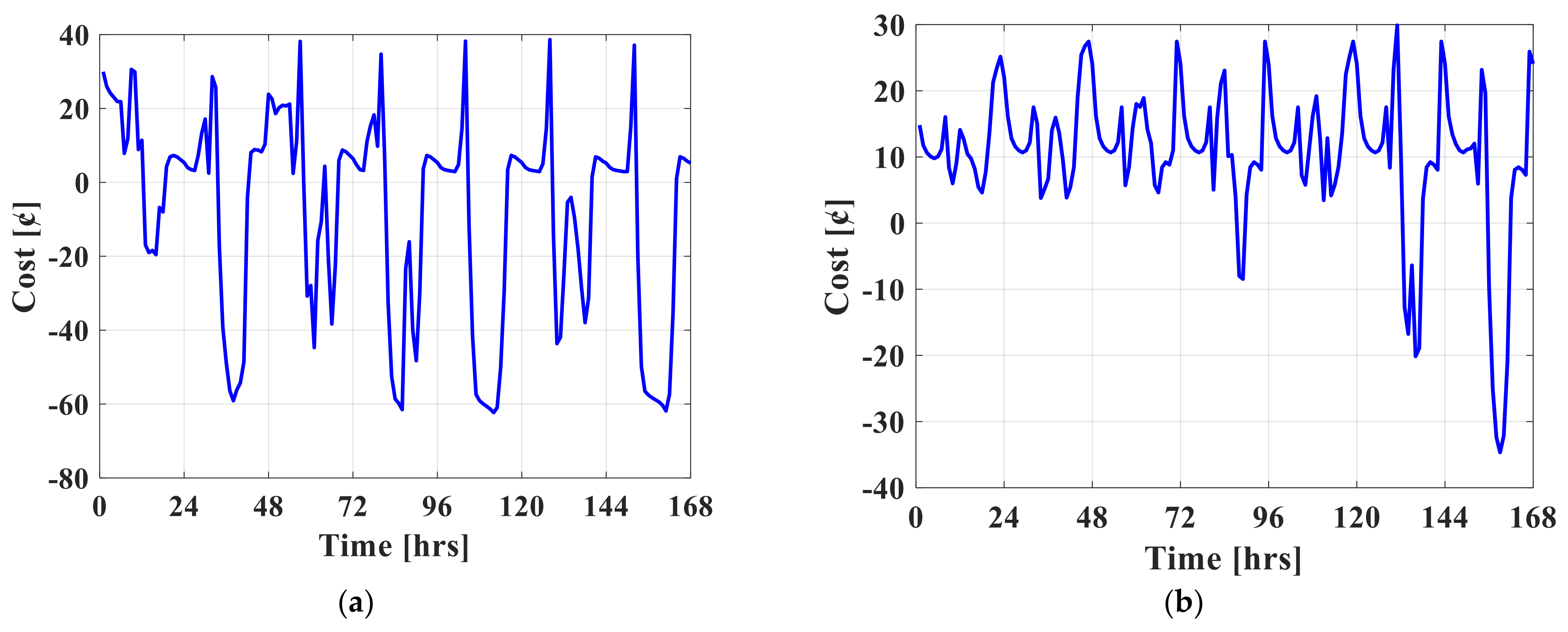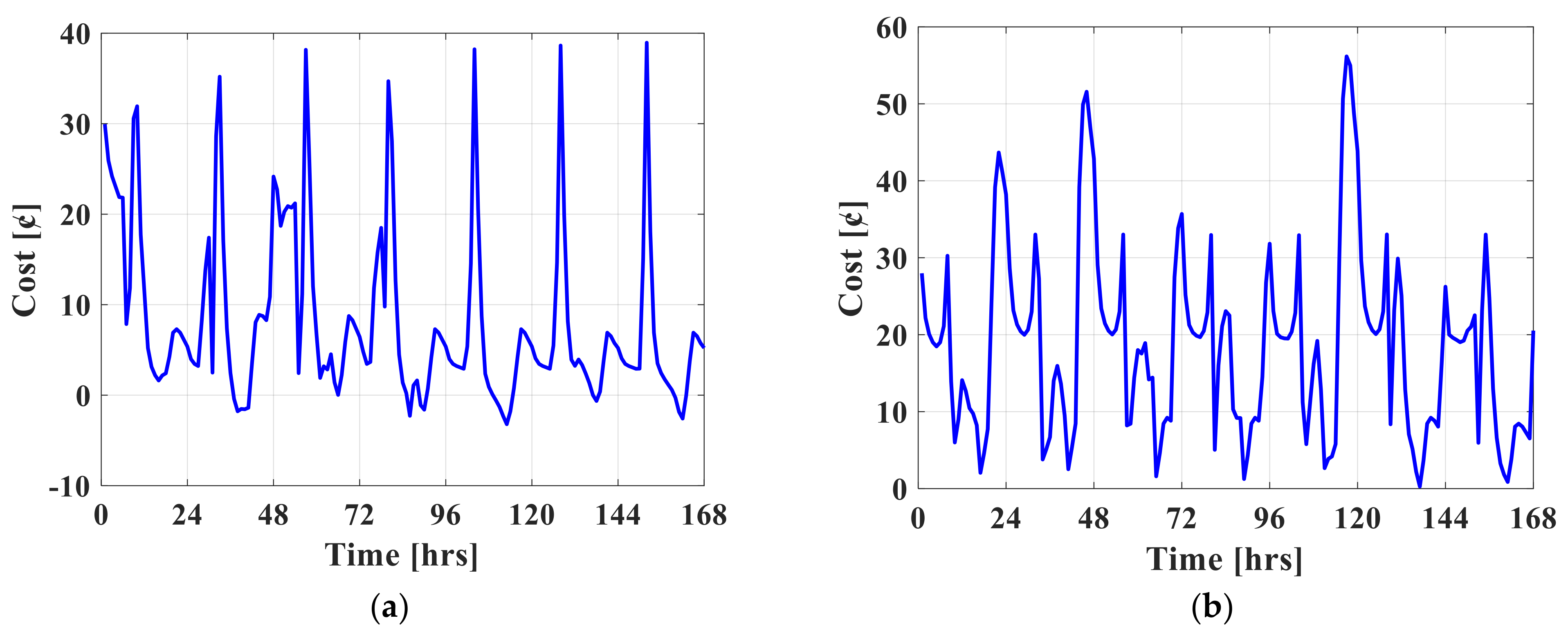1. Introduction
1.1. Background and Motivation
Renewable energies, especially solar energy, have been rapidly developed globally in the past decade. Air pollution reduction and the falling cost of solar photovoltaic (PV) technologies are the main reasons for its high integration in power systems [
1,
2]. The global average price of a solar PV module has been dropped by 92% between 2000 and 2019 [
3]. Rooftop solar PV is the most suitable type of renewable energy source for installation on the premises of residential households [
4]. It is estimated that the global capacity of residential solar PV in 2024 will be more than twice of that in 2018 [
3].
In addition to the international scope, renewable energy in Australia has received a significant amount of attention. Renewable energy reports show that wind, hydro, and small-scale PV are the top three renewable resources, accounting for 35.4%, 25.7% and 22.3% of energy production in Australia in 2019, respectively [
5]. The total annual electricity generation by renewable energy has reached 24% of the electricity consumption in the country [
5]. In addition, the installation of small-scale rooftop solar PV in 2019 reached 2.2 GW, which exceeds the previous record of 1.6 GW in 2018 [
5].
With such a high penetration of renewable energy resources in the world, several problems have been revealed including variability and intermittency [
6,
7]. Installing a hybrid grid-connected renewable energy system (RES) with the integration of energy storage systems is an efficient solution to overcome these drawbacks [
8,
9]. Therefore, a reasonable control of the energy resources and storage system faces new challenges which are of a high complexity. To address this issue, an effective energy management system (EMS) is an essential feature for RES to be of the highest economic benefit for consumers [
10].
Currently in South Australia (SA), an area with a high penetration of solar PV, the feed-in-tariff (FiT) is almost three times lower than the retail price (RP) [
11]. This reduces the household’s revenue when excess solar PV energy is sold to the grid [
12]. On the other hand, an RES may not result in an electricity cost reduction if not operated properly [
13]. Besides, different electricity tariffs such as flat rates and ToU rates provide a variety of options for consumers, thereby affecting the performance of the installed RES [
14,
15]. Conventional EMSs are mostly developed based on one specific electricity rate, which lacks a reference value under the current electricity pricing programs. The ToU scheme enables the consumers to reduce electricity bills by appropriately managing energy usage. Hence, the EMSs attract more attention to achieve the best performance with the highest benefits. Increasing the penetration level of solar PV and battery energy storage, as well as different prices for exchange electricity tariffs are the motivations for the researchers to develop new EMSs.
1.2. Literature Review and Research Gaps
A literature review focuses on the design of EMS for economic benefits of grid-connected houses under flat and ToU electricity pricing programs. Yuce, et al. [
16] presented a hybrid power management system based on Artificial Neural Networks and Genetic Algorithm. The proposed system maximised the use of the PV and wind turbine, and reduced the energy imported from the grid. However, the storage system was ignored. García, et al. [
17] proposed an off-grid hybrid energy system composed of wind turbine, PV, and energy storage system. A fuzzy logic control (FLC) method was chosen for the EMS algorithm. The proposed EMS with FLC ensured a 13% cost reduction and a longer system lifetime. However, the system was stand-alone, which constrained its development based on electricity tariffs.
In [
18], a hybrid grid-connected RES containing PV, battery, and supercapacitor was proposed. The proposed scheme changed the modes of RES during different renewable energy and load level. The storage system ensured the reliability of the system, however, ToU rates were not considered in that system. Abushnaf, et al. [
19] introduced an EMS to control the residential energy usage with the ToU rates. The results showed that the designed EMS could minimize the user electricity cost. However, the battery degradation cost was not considered. By overlooking the effect of degradation, the simulation may achieve inaccurate results.
Zhang and Tang [
20] conducted a study on the optimal scheduling of a grid-connected EMS. The proposed system optimised the energy schedule between solar PV, battery, and the utility grid. The ToU and step tariffs were considered, and a genetic algorithm was employed as the optimisation method. The study showed that the proposed genetic algorithm-based EMS can achieve a decent performance and satisfy the system requirements. However, the battery degradation costs, and the generation costs of the renewable components were overlooked. In [
21], the EMS problem of a grid-connected home was formulated as an optimisation problem. The house was integrated with wind turbine, solar PV, and battery. However, the study neglected battery’s degradation cost and only considered one electricity tariff.
A grid-connected energy system with PV and battery was proposed in [
22] for a case study in Sweden. The study employed the rule-based method to control the energy flow of the system. A genetic algorithm was introduced to optimise the size of the battery. The results showed that a hybrid renewable energy system was more attractive than a conventional system after price reduction of the battery. The same PV-battery system was examined for residential households in Australia [
23,
24]. However, battery degradation and ToU rates were not considered in those studies. In [
25], a rule-based EMS was evaluated for residential grid-connected homes with PV-battery system in The Netherlands and USA. However, the EMS was so general, and it was based on a net metering scheme. In some studies [
26,
27,
28], a predictive part has been added in the EMS design to forecast the load consumption of PV generation. Lack of predictiveness is one of the limitations of the current study. However, it should be noted that predictive optimization systems achieve proper results if and only if accurate prediction is available. In real world scenarios, a bad prediction may be very pricey for the quality of the control and overall power usage/cost.
Table 1 lists a summary of drawbacks of the existing studies based on EMS model, equivalent PV cost, battery degradation cost, grid constraint, and electricity tariff. As illustrated in the table, rule-based EMS models are mostly used in the existing studies. The main issue with optimisation-based EMS model is its practicality. The optimization-based models do not provide any information on how the proposed optimized EMS is implemented in practice. The degradation cost of battery was not addressed in most of the existing studies. Only one electricity tariff was evaluated in the existing studies and no comparison was provided for different electricity tariffs. In addition, the grid constraint was rarely addressed.
1.3. Contribution
The motivation of this work is to address a timely topic of practicing engineering problem for a real case study. The key contribution of this paper is to develop four new practical rule-based home EMSs for grid-connected households with solar PV and battery by considering different rates for purchasing and selling electricity. To the best of the authors’ knowledge, this is the first study that proposes and compares different rule-based EMSs for flat and ToU electricity tariffs. An important feature of the developed rule-based EMSs is their practicality which means that they can be easily employed for the customers. The EMSs are developed based on different options of flat and ToU (peak, off-peak, and shoulder) electricity rates for buying and selling prices, i.e., RP and FiT. Hence, four different options are investigated in this study: (1) flat-flat, (2) ToU-flat, (3) flat-ToU, and (4) ToU-ToU. These EMSs are used to control the power flow of the system among PV, battery, grid, and load based on the electricity rate of RP and FiT by considering the grid constraint. As a scientific contribution, the proposed EMSs updated the power flow not only based on the PV generation, but also based on the electricity price. The main aim is to reduce the operation cost of electricity for a typical house with optimal capacities of PV and BESS. The operation cost is calculated based on the cost of electricity exchange within grid, the equivalent cost of PV generation, and the cost of battery degradation. The operation of the grid-connected house with rooftop PV and battery is evaluated for a sunny week in summer and a cloudy week in winter. The operation analysis involves the power operation and cost calculation. The developed rule-based EMSs are generic and can be applied for any case study. A grid-connected house in South Australia is considered to examine the proposed EMSs of this study. For this purpose, real data of solar radiation, air temperature, and electricity consumption are used for a week in summer and a week in winter. The electricity rates and components prices are selected according to the current market prices in South Australia.
2. Energy Management Systems
The EMSs are designed for a typical grid-connected house with rooftop solar PV and battery energy storage.
Figure 1 demonstrates the system configuration of the grid-connected home with the EMS. It is assumed that rooftop solar PV and battery storage are installed in the premises of the household. The generated power of the PV can be used for load supply, battery charging, and selling electricity to the grid. The installed battery can only be charged by the solar PV. Hence, there is a power connection between the installed PV and the battery. The solar PV can charge the battery, if required, with this connection. As illustrated, the EMS receives the signals from the load consumption, PV generation, available charge/discharge energy of battery, and the electricity price. Then, the EMS controls the power flow between the components. The capacities of PV and battery are selected based on our previous study for optimal sizing of a typical grid-connected house [
23].
In this study, rule-based EMSs are developed due to practicality, simplicity, user-friendliness, low computational requirement, and ease of implementation in practice. In these methods, all considered rules are explicit for the customers and designers. It is notable that the rules are designed based on the experiences of the expert on the operation of the solar PV and battery systems. This is another feature of rule-based EMSs that give the designer sufficient flexibility to update the rules.
In this study, different EMSs are developed for four options based on electricity prices for buying and selling.
Table 2 shows these four different options in terms of electricity buying and selling tariffs.
Table 3 presents the rates and periods for the Flat and ToU electricity price data of the case study in South Australia. The flat rate of electricity selling is almost one third of the electricity buying [
23]. The ToU rate is changed based on three periods of the day: off-peak, shoulder, and peak periods [
4]. The peak period is between 6 pm and 11 pm, the off-peak period starts from 11 pm to 8 am, and the shoulder period starts from 8 am to 6 pm.
Table 3 lists the electricity buying and selling prices under flat and ToU rates.
2.1. Option 1: Flat-Flat
The flow chart of the developed rule-based EMS for this option is demonstrated in
Figure 2. The inputs of the EMS are the PV generation, load consumption, and grid constraint. In this option, the buying and selling electricity are both flat rates which means the electricity price remains constant all the time.
When renewable energy exceeds the household load, the extra power charges the battery storage by considering the input power limit. This can be expressed as:
where
represents the charged power of battery,
is renewable power delivered by PV, and
is the household load. The input power limit of battery (
) is formulated as follows:
where
and
are the available power and energy rating of the battery storage. State of charge (SOC) of battery is limited during the charging interval by the maximum limit (
).
The SOC of battery at charging time interval (
) is calculated as follows:
where
is the charging efficiency of battery.
Any extra power of PV after charging the battery will be exported to the grid by considering the grid constraint for the maximum export power. Hence, the exported power is formulated as follows:
where
is the exported power from the household to grid and
stands for the maximum power that the grid can accept from the household.
If the generated power of solar PV exceeds the load, charging of battery, and export power limit of the grid, then the extra power is dumped by the control system of the inverter:
When PV generation cannot supply the household load, the energy deficiency is supplied by the battery and grid. If there is enough energy in the battery to fully supply the load, then the battery is discharged by considering its output power limit:
where
is the discharged power of battery.
The output power limit of battery (
) is formulated as follows:
where
is the minimum SOC of the battery in the operation.
The SOC of battery at discharging time interval (
) is calculated as follows:
where
is the discharging efficiency of battery.
If battery and PV could not supply the household load completely, then the power deficiency is purchased (i.e., imported from the grid):
where
is the imported power from the grid.
2.2. Option 2: ToU-Flat
For option 2, the electricity selling price is fixed; however, the electricity purchasing price is based on ToU rates. Therefore, the EMS retains the selling method used in option 1 and it only changes the purchase method. During the peak period of ToU, the purchased electricity price of the grid is very high, so that the energy in the battery should be consumed when PV energy is insufficient. Therefore, the electricity supply priority of battery and grid during the peak period is for the battery storage. The flow chart is the same as
Figure 2.
The flow chart of the developed rule-based EMS during shoulder and off-peak periods of option 2 is demonstrated in
Figure 3. It may be mentioned that the power flow equations are only stated for option 1 to avoid repetition in this paper. During the shoulder (8 am to 6 pm) and off-peak (11 pm to 8 am) periods, the purchase electricity price of the grid is relatively low, so the insufficient energy of the household should be firstly supplied by the grid. Therefore, the electricity supply priority of battery and grid during shoulder and off-peak periods is for purchasing from the grid. Two benefits can be noted for the developed EMS for this option: (i) the electricity is purchased from the grid with lower price during shoulder and off-peak, and (ii) the energy is saved in the battery for the upcoming peak period.
2.3. Option 3: Flat-ToU
For option 3, the purchase price is fixed; however, the electricity selling price is based on ToU rates. Therefore, the rule-based EMS retains the purchase method used in option 1 and only changes the selling method. During the peak period, the FiT is higher than other periods, so the surplus power of solar PV should firstly be exported to the grid. The flow chart of the developed rule-based EMS during the peak period for this option is demonstrated in
Figure 4.
During the off-peak period, the selling price is low, so that the household would prefer to store energy in the battery. During the shoulder, storing energy in the battery can reduce the energy purchased from the grid in the upcoming peak hours. Hence, the flow chart for shoulder and off-Peak is the same as
Figure 3.
2.4. Option 4: ToU-ToU
For option 4, both purchase and selling prices are based on ToU rates. During the peak period, the purchase and selling prices are relatively high. Hence, the household should increase electricity selling to the grid and reduce electricity purchase from the grid. This method is similar to that used in the peak period of option 3, and the flow chart for the EMS in option 4 during the peak period is the same as
Figure 4. During the off-peak period, the purchase and selling prices are relatively low. Therefore, the household should reduce electricity selling to the grid and increase electricity purchase from the grid. This method is similar to that of the off-peak period of the option 2, and the flow chart for the EMS in option 4 during the off-peak period is the same as
Figure 3. During the shoulder period, the extra energy in the PV can be stored in the battery for the upcoming peak period. The other parts remain normal as the flat-flat method. Therefore, the flow chart of the shoulder period for option 4 is the same as
Figure 2.
In summary, there is only one flow chart used in option 1 (Flat-Flat). Option 2 (ToU-Flat) and option 3 (Flat-ToU) include two flow charts for the rule-based EMS. In option 4 (ToU-ToU), there are three flow charts used for peak, off-peak, and shoulder periods of the developed rule-based EMS.
3. System Cost Model
In this section, the system cost model is explained for the developed EMSs. It is notable that the nine-step cost-benefit analysis is generally used for the long-term projects where the net present cost of the project should be calculated based on the discount rate. The authors have done this analysis for optimal sizing of solar PV and BES in a 20-year project lifespan for the same case study [
4,
23]. However, in this work, the main focus is on energy management of the household in which the operation cost is calculated only for one week (168 h).
The total operation cost of the EMS can be calculated based on the costs of PV generation, battery degradation, as well as the electricity trading cost with the grid.
Here, is the total operation cost. , , and are the equivalent costs of PV, battery, and grid, respectively. The superscripts and indicate the import and export of the variables. , , and are the corresponding energy of PV generation, battery charging/discharging, and grid, respectively. T is the total hours of the simulation.
The imported or exported energies are calculated based on the trading power. In the simulation, the data is processed in each hour, therefore one power results in one energy. The energy transferred by each component is calculated as:
where
is the generated power by the solar PV at time
t. In addition,
and
are the charging and discharging power of battery at time
t.
The equivalent cost of PV production can be expressed by:
where
is the annual generated energy by 1-kW PV.
and
are the rating power and capital cost of the installed solar PV system, respectively.
The equivalent cost of the PV is obtained by its capital cost in the first year. Hence, PVF which is the present value function is used. PVF is calculated based on the discount rate
and component lifetime
as follows:
The degradation cost of battery can be calculated by [
29]:
where
is the maintenance cost of battery,
is the capital cost of battery, and
is the deliverable energy of 1-kWh battery during its lifetime, and
is the capacity of the installed battery.
4. Case Study
The developed rule-based EMSs are generic and can be applied for any case study. In this paper, a grid-connected house in SA is selected as the case study. It is assumed that the household is already equipped with rooftop solar PV and battery storage. The meteorological data required for solar PV, load data of the household, electricity prices, and components parameters and economic data of the system are explained in this section.
4.1. Meteorological Data
The weekly meteorological data of the location of the case study is obtained from the Australian Government Bureau of Meteorology [
30].
Figure 5 demonstrates the temperature and insolation for a week in summer and a week in winter. The ambient temperature in SA varies significantly between summer and winter. The averages of temperature in summer and winter are 34.3 °C and 13.5 °C, respectively. In terms of solar insolation, more insolation can be obtained in summer compared to winter. The peaks of solar insolation for summer and winter are 1.03
and 0.58
, respectively.
4.2. Household Load Data
The weekly load consumption of the grid-connected household in SA is shown in
Figure 6 [
23]. The average load consumption during summer and winter is 0.788 kW and 0.796 kW, respectively. And the peak load of winter in this case study is 1.44 kW, which is about 0.4 kW higher than that of summer [
31].
4.3. Parameters and Economic Data of Components
Table 4 lists the parameters and economic data of solar PV and battery storage. All the economic values are in the Australian dollar. The economic data of solar PV is taken from [
32]. The capacity of solar PV and battery is selected based on the optimal configuration of a PV-Battery system following the actual data of SA. In [
23], optimal sizing of solar PV and battery storage was developed for a typical grid-connected household in South Australia. It was found that a grid-connected household can achieve the lowest electricity cost with a 9 kW solar PV and 11 kWh battery system. Hence, in this study, the capacities of PV and battery are selected as 9 kW and 11 kWh for the economic analysis of the rule-based EMSs. The total deliverable energy of 1-kWh battery during its lifetime is considered as 6200 kWh.
It may be noted that according to South Australian Power Network policies, the single-phase customers cannot export more than 5 kW to the grid at any time [
33].
5. Results and Discussions
This section presents the economic and operational results of the proposed rule-based EMSs for each option of the case study.
5.1. Weekly Power Flow
The simulation results of power flow during a week in summer and winter are investigated to examine the proper operation of the system based on the proposed EMSs.
5.1.1. Power Flow in Option 1 (Flat-Flat)
Figure 7 shows the weekly power flow of the house with the rule-based EMS under Flat-Flat rates for a week in summer and winter. According to
Table 3, the electricity buying and selling prices are fixed at 0.48 AUD/kWh and 0.17 AUD/kWh, respectively. The solar PV output generation in summer is much higher than that of winter. The peak output power of the 9-kW solar PV panel in summer and winter is 7 kW and 4.34 kW, respectively. In terms of the household load, electricity consumption in winter has increased slightly compared to summer. The total electricity consumption in the considered weeks of summer and winter is 132.31 kWh and 133.76 kWh, respectively. It may be mentioned that the last two days of the week demonstrate the weekend in the profile. The green line indicates the battery power where a positive value means the battery is charged, and a negative value means the battery is discharged. Regarding the grid power, the total purchased and sold electricity from/to the grid in summer are 7.82 kWh and 229.97 kWh, respectively. The corresponding values in winter are 44.20 kWh and 23.15 kWh, respectively, which show that higher electricity should be purchased from the grid. In contrary, the household sells more electricity to the grid in summer week. The sold electricity to the grid does not exceed 5 kW at any time which shows that the grid constraint is properly satisfied by the rule-based EMS.
5.1.2. Power Flow in Option 2 (ToU-Flat)
Figure 8 illustrates the weekly power flow of the household with the rule-based EMS under ToU-Flat rates for a week in summer and winter. The profiles of load consumption and PV generation remain the same, and the battery charging/discharging as well as grid exchange are changed according to the different power flow. Compared to the Flat-Flat, this operation option enables the EMS to stop buying electricity from the grid when the electricity price is relatively high at peak time. The battery is discharged during the peak period (from 6 pm to 9 pm) compared to Flat-Flat option. In summer, the purchased electricity from the grid is 34.97 kWh, and the sold electricity to the grid is 260.76 kWh. In winter, the purchased and sold electricity of the grid are 49.51 kWh and 28.10 kWh, respectively. It can be noted that the exchanged electricity between the grid is increased for both seasons compared to Flat-Flat option. The reason can be explained by the fact that no electricity is purchased from the grid during the peak period, so the energy of the battery is consumed in advance. Therefore, in the following off-peak periods, the energy purchased from the grid is increased due to the drop in electricity purchase price and the insufficient energy storage of the battery.
Figure 9 shows another analysis for one day (24 h) power flow and electricity rates variations for the grid-connected house under Flat-ToU rates in summer and winter.
As shown, when the electricity buying is at peak time, the battery storage discharges to supply the load. In winter, the amount of battery discharging is not enough during the peak time to supply the load and hence the remaining electricity is purchased from the grid.
5.1.3. Power Flow in Option 3 (Flat-ToU)
Figure 10 shows the weekly power flow of the household with the rule-based EMS under Flat-ToU rates for a week in summer and winter. Unlike
Figure 8, the purchase price is fixed at 0.48 AUD/kWh and the selling price varies in different periods. In this option, the rule-based EMS sells excess renewable energy generation to the grid during peak periods, while it stores the excess renewable energy in the battery for off-peak and shoulder periods. A clear difference can be noticed during the peak period in winter between
Figure 10 and
Figure 8. However, there is no significant difference between those in summer.
5.1.4. Power Flow in Option 4 (ToU-ToU)
Figure 11 indicates the weekly power flow of the household with the rule-based EMS under ToU-ToU rates for a week in summer and winter. In this option, both the purchase and sale prices vary according to
Table 3 over time. During peak periods, the developed rule-based EMS would prefer to discharge the battery and sell the remaining PV power to the grid. Similarly, the EMS would prefer to use the utility grid to supply the load and store the available power in the battery during off-peak period. According to
Figure 11, the battery is discharged during peak hours, so the green line coincides with the x-axis in the early morning. The electricity sold to the grid has a significant rise during the peak period.
5.2. Electricity Cost Variations
The electricity cost variation of the proposed rule-based EMSs is investigated in this section. According to the previous section, the power flow between different components was obtained, and hence the household electricity cost can be calculated according to the cost model section for each component.
5.2.1. Electricity Cost in Option 1 (Flat-Flat)
Figure 12 demonstrates the electricity cost variations under Flat-Flat rates for both seasons. The positive value means the expenditure (household payment) and the negative value mean the income (household’s income by selling electricity) of the household. For both summer and winter, the cost reduces when the solar PV system generates power, which is shown in the figure as a sharp curve at noon. The majority of the cost is negative in summer, which suggests that the householder can earn money from the system. The hourly cost of the household ranges from −0.62 AUD to 0.39 AUD in summer and the average cost of the system is −0.8 AUD per hour. In winter, the cost has increased substantially due to the insufficiency of solar insolation. There are still three days in a week to earn profits when solar radiation is adequate. The electricity cost in winter varies between −0.31 AUD and 0.56 AUD, with an average cost of 0.17 AUD per hour.
5.2.2. Electricity Cost in Option 2 (ToU-Flat)
Figure 13 indicates the electricity cost variations under ToU-Flat rates for both seasons. Similar to the previous results, the economic income in summer is significantly higher than that of winter. In summer, the electricity cost varies between −0.63 AUD and 0.31 AUD with an average cost of −0.11 AUD per hour. The maximum and minimum costs in winter are 0.0 AUD and −0.35 AUD, respectively. The average cost is obtained as positive 0.11 AUD per hour in winter. In addition, the maximum expenditure in this option is reduced compared to that of option 1, especially in summer where the peak cost is 0.30 AUD.
5.2.3. Electricity Cost in Option 3 (Flat-ToU)
Figure 14 illustrates the electricity cost variations under Flat-ToU rates for both seasons. The ToU rates of selling electricity are low in off-peak and shoulder periods. On the other hand, the output power of solar PV is mostly available during those periods. Therefore, it can be seen that the electricity cost variations are almost positive for both seasons. It means that the household profit by selling electricity to the grid is significantly decreased compared to previous options. The electricity cost in summer varies from −0.3 AUD to 0.39 AUD with an average of 0.8 AUD per hour. This scenario becomes serious in winter, with the cost variation from 0.0 AUD to 0.56 AUD with an average of 0.19 AUD per hour.
5.2.4. Electricity Cost in Option 4 (ToU-ToU)
Figure 15 demonstrates the electricity cost variations under ToU-ToU rates for both seasons. It can be noted that both expenditure and income of the household are reduced compared to other options, which is reasonable because the ToU-ToU mode has the characteristics of both the ToU-flat option and the flat-ToU option. The cost of the household in summer fluctuates from −0.3 AUD to 0.32 AUD, with an average cost of 0.8 AUD per hour. However, in winter, the costs are between 0.0 AUD and 0.30 AUD, and the average cost is 0.13 AUD per hour.
5.3. Economic Analysis and Comparison of the Rule-Based EMSs
This section investigates the total electricity cost of the proposed rule-based EMSs for the households with each option. Hence, the best option can be found with the highest economic benefits. The comparison is provided for both summer and winter seasons separately.
Table 5 shows the key performance indicators (KPIs) for comparison of the economic analysis of the proposed EMS under four different options in summer. The last row in the table indicates the anticipated cost when the load (132.3 kWh) is completely supplied by the utility grid. The cost of PV generation is the same for all options because the same environmental data is used to calculate the PV output power. Due to the sufficient solar resources in summer, the proposed EMS can significantly reduce the electricity cost of the customer for all options. The Flat-Flat option and ToU-Flat option have larger energy sales revenue than that of the other two options. In terms of the total cost, the ToU-Flat option has the minimum cost and hence the best economic benefit compared to other options. In ToU-Flat option, the customer can earn 17.86 AUD during the week in summer. The system also has the lowest battery degradation cost.
Table 6 shows the key performance indicators (KPIs) for comparison of the economic analysis of the proposed EMS under four different options in winter. The total electricity consumption for this sample week in winter is 133.8 kWh. Similarly to the week in summer, the minimum cost (17.90 AUD) is obtained under the ToU-Flat option. Although no profit could be obtained by the EMSs in winter, the actual cost under the ToU-Flat mode is 47% lower than the case of completely importing power from the grid to meet the load.
By comparing
Table 5 with
Table 6, it can be concluded that the best economic profit can be obtained for option 2 where the ToU rates are used for electricity buying and the Flat rate is used for electricity selling. The main reason can be discussed first by Flat rate for electricity selling and ToU rate for electricity buying. The current Flat rate is 0.17 AUD/kWh; however, within the ToU rate, the selling electricity rate is 0.18 AUD/kWh only for the peak time and it is too low for shoulder and off-peak. Hence, since the peak time is the evening and PV cannot sell electricity at that time, the ToU rate for electricity selling is not affordable. On the other hand, the Flat rate for electricity buying is not affordable since it imposes a 0.48 AUD/kWh for purchased electricity at any time. However, within the ToU for the electricity buying, the customer only pays a high rate of 0.58 AUD/kWh for the peak time, and at shoulder and off-peak the electricity price is low.
6. Conclusions and Future Works
The main contribution of this paper was to develop four novel practical rule-based home EMSs for grid-connected households with solar PV and battery by considering different tariffs for purchasing and selling electricity. An important feature of the developed rule-based EMSs was their practicality which means that they could be easily employed for the customers. Flat and ToU rates were evaluated for four different options for electricity purchase and sale prices: (1) Flat-Flat, (2) ToU-Flat, (3) Flat-ToU, and (4) ToU-ToU. The developed rule-based EMSs considered the electricity price, generation of PV, load consumption of home, energy in the battery, and the grid constraint. As a new contribution, the proposed EMSs updated the power flow not only based on the PV generation, but also based on the electricity price. The operation cost was calculated based on the electricity exchange with main grid, equivalent cost of PV generation, as well as the degradation cost of battery storage. It was found that the ToU-Flat option reached the lowest electricity cost in both seasons for the customers based on the developed rule-based EMS. The Flat-ToU option is not recommended for the customers since it has the highest electricity cost for both weeks of operation. The total operation cost for the ToU-Flat option (17.90 AUD) was almost half of that of Flat-ToU option (31.30 AUD) for winter. In addition, it was almost one third for the summer season.
Future studies can focus on new rule-based energy management based on real-time pricing. In such a study, an accurate electricity price forecasting plays an important role to develop the rules of the EMS.
Author Contributions
Conceptualization, X.P., R.K. and A.M.; methodology, R.K. and X.P.; software, R.K. and X.P.; validation, X.P., R.K. and A.M.; formal analysis, A.M., A.Y. and G.S.; investigation, R.K.; resources, A.M.; data curation, R.K.; writing—original draft preparation, R.K. and X.P.; writing—review and editing, A.M., A.Y. and G.S.; visualization, R.K.; supervision, A.M.; project administration, A.M.; funding acquisition, A.M., A.Y. and G.S. All authors have read and agreed to the published version of the manuscript.
Funding
This research received no external funding.
Institutional Review Board Statement
Not applicable.
Informed Consent Statement
Not applicable.
Data Availability Statement
Not applicable.
Conflicts of Interest
The authors declare no conflict of interest.
Nomenclature
| Abbreviations |
| EMS | Energy management system |
| FiT | Feed-in-tariff |
| PV | Photovoltaic |
| RES | Renewable energy system |
| RP | Retail price |
| SA | South Australia |
| ToU | Time-of-use |
| Parameters |
| Equivalent operation cost of battery ($) |
| Maintenance cost of battery ($) |
| Capital cost of battery ($) |
| Equivalent cost of exported energy to the grid ($) |
| Equivalent cost of imported energy from the grid ($) |
| Equivalent operation cost of PV ($) |
| Capital cost of the installed solar PV system ($) |
| Total operation cost of the system ($) |
| Energy rating of battery (kWh) |
| Total charging/discharging energy of battery in the operation period (kWh) |
| Deliverable energy of 1-kWh battery during its lifetime (kWh) |
| Exported energy to grid (kW) |
| Imported energy from grid (kW) |
| Generated energy of the installed solar PV system (kWh) |
| annual generated energy by 1-kW PV |
| Discount rate (%) |
| Component’s lifetime (year) |
| Charging power of battery (kW) |
| Discharging power of battery (kW) |
| Available input power of battery (kW) |
| Available output power of battery (kW) |
| Load consumption (kW) |
| Dumped power (kW) |
| Export power to grid (kW) |
| Import power from grid (kW) |
| Maximum export power limit to grid (kW) |
| Rating power of the installed solar PV system (kW) |
| Generated power of solar PV (kW) |
| Present value function |
| capacity of the installed battery (kWh) |
| State of charge of battery (%) |
| Minimum/maximum limit of SOC (%) |
| Total time intervals (hr) |
| Charging/discharging efficiency of battery (%) |
| Interval of time (hr) |
References
- Fathi, M.; Khezri, R.; Yazdani, A.; Mahmoudi, A. Comparative study of metaheuristic algorithms for optimal sizing of standalone microgrids in a remote area community. Neural Comput. Appl. 2021, volume, 1–19. [Google Scholar] [CrossRef]
- Combe, M.; Mahmoudi, A.; Haque, M.; Khezri, R. Cost-effective sizing of an AC mini-grid hybrid power system for a remote area in South Australia. IET Gener. Transm. Distrib. 2018, 13, 277–287. [Google Scholar] [CrossRef]
- Our World in Data, Solar PV Module Prices. Available online: https://ourworldindata.org/grapher/solar-pv-prices (accessed on 2 March 2021).
- Javeed, I.; Khezri, R.; Mahmoudi, A.; Yazdani, A.; Shafiullah, G. Optimal sizing of rooftop PV and battery storage for grid-connected houses considering flat and time-of-use electricity rates. Energies 2021, 14, 3520. [Google Scholar] [CrossRef]
- Clean Energy Australia. Available online: https://assets.cleanenergycouncil.org.au/documents/resources/reports/clean-energy-australia/clean-energy-australia-report-2020.pdf (accessed on 3 January 2021).
- Olatomiwa, L.; Mekhilef, S.; Ismail, M.; Moghavvemi, M. Energy management strategies in hybrid renewable energy systems: A review. Renew. Sustain. Energ. Rev. 2016, 62, 821–835. [Google Scholar] [CrossRef]
- Shafiullah, G.; Oo, A.M.; Ali, A.S.; Jarvis, D.; Wolfs, P. Economic analysis of hybrid renewable model for sub-tropical climate. Int. J. Therm. Environ. Eng. 2010, 2, 57–65. [Google Scholar] [CrossRef][Green Version]
- Khezri, R.; Mahmoudi, A. Review on the state-of-the-art multi-objective optimisation of hybrid standalone/grid-connected energy systems. IET Gener. Transm. Distrib. 2020, 14, 4285–4300. [Google Scholar] [CrossRef]
- Shoeb, M.A.; Shafiullah, G.M. Renewable energy integrated islanded microgrid for sustainable irrigation—Bangladesh per-spective. Energies 2018, 11, 1283. [Google Scholar] [CrossRef]
- Luo, F.; Ranzi, G.; Wan, C.; Xu, Z.; Dong, Z.Y. A multistage home energy management system with residential photo-voltaic penetration. IEEE Trans. Ind. Inform. 2019, 15, 116–126. [Google Scholar] [CrossRef]
- Sharma, V.; Aziz, S.M.; Haque, M.H.; Kauschke, T. Effects of high solar photovoltaic penetration on distribution feeders and the economic impact. Renew. Sustain. Energ. Rev. 2020, 131, 110021. [Google Scholar] [CrossRef]
- Khezri, R.; Mahmoudi, A.; Haque, M.H. SWT and BES optimisation for grid-connected households in South Australia. In Proceedings of the 2019 IEEE Energy Conversion Congress and Exposition (ECCE), Baltimore, MD, USA, 29 September–3 October 2019; pp. 418–425. [Google Scholar]
- Khezri, R.; Mahmoudi, A.; Haque, M.H. A Demand Side Management Approach for Optimal Sizing of Standalone Renewable-Battery Systems. Available online: https://ieeexplore.ieee.org/document/9442868 (accessed on 12 August 2021).
- Shareef, H.; Ahmed, M.S.; Mohamed, A.; Al Hassan, E.J.I.A. Review on home energy management system considering demand responses, smart technologies, and intelligent controllers. IEEE Access 2018, 6, 24498–24509. [Google Scholar] [CrossRef]
- Rahman, M.M.; Hettiwatte, S.; Shafiullah, G.M.; Arefi, A. An Analysis of the time of use electricity price in the residential sector of Bangladesh. Energ. Strategy Rev. 2017, 18, 183–198. [Google Scholar] [CrossRef]
- Yuce, B.; Rezgui, Y.; Mourshed, M. ANN-GA smart appliance scheduling for optimised energy management in the domestic sector. Energ. Build. 2016, 111, 311–325. [Google Scholar] [CrossRef]
- García, P.; Torreglosa, J.P.; Fernández, L.M.; Jurado, F. Optimal energy management system for stand-alone wind turbine/photovoltaic/hydrogen/battery hybrid system with supervisory control based on fuzzy logic. Int. J. Hydrog. Energ. 2013, 38, 14146–14158. [Google Scholar] [CrossRef]
- Tummuru, N.R.; Mishra, M.K.; Srinivas, S. Dynamic energy management of renewable grid integrated hybrid energy storage system. IEEE Trans. Ind. Electron. 2015, 62, 7728–7737. [Google Scholar] [CrossRef]
- Abushnaf, J.; Rassau, A.; Górnisiewicz, W. Impact of dynamic energy pricing schemes on a novel multi-user home energy management system. Electr. Power Syst. Res. 2015, 125, 124–132. [Google Scholar] [CrossRef]
- Zhang, S.; Tang, Y. Optimal schedule of grid-connected residential PV generation systems with battery storages under time-of-use and step tariffs. J. Energy Storage 2019, 23, 175–182. [Google Scholar] [CrossRef]
- Merdanoğlu, H.; Yakıcı, E.; Doğan, O.T.; Duran, S.; Karatas, M. Finding optimal schedules in a home energy management system. Electr. Power Syst. Res. 2020, 182, 106229. [Google Scholar] [CrossRef]
- Zhang, Y.; Lundblad, A.; Campana, P.E.; Benavente, F.; Yan, J. Battery sizing and rule-based operation of grid-connected photovoltaic-battery system: A case study in Sweden. Energy Convers. Manag. 2017, 133, 249–263. [Google Scholar] [CrossRef]
- Khezri, R.; Mahmoudi, A.; Haque, M.H.H. Optimal capacity of solar PV and battery storage for Australian grid-connected households. IEEE Trans. Ind. Appl. 2020, 56, 5319–5329. [Google Scholar] [CrossRef]
- Sharma, V.; Haque, M.H.; Aziz, S.M. Energy cost minimization for net zero energy homes through optimal sizing of battery storage system. Renew. Energy 2019, 141, 278–286. [Google Scholar] [CrossRef]
- Bandyopadhyay, S.; Mouli, G.R.C.; Qin, Z.; Elizondo, L.R.; Bauer, P. Technoeconomical model based optimal sizing of PV-battery systems for microgrids. IEEE Trans. Sustain. Energy 2019, 11, 1657–1668. [Google Scholar] [CrossRef]
- Shakeri, M.; Shayestegan, M.; Abunima, H.; Reza, S.S.; Akhtaruzzaman, M.; Alamoud, A.R.M.; Amin, N. An intelligent system architecture in home energy management systems (HEMS) for efficient demand response in smart grid. Energy Build. 2017, 138, 154–164. [Google Scholar] [CrossRef]
- Liberati, F.; Di Giorgio, A.; Giuseppi, A.; Pietrabissa, A.; Habib, E.; Martirano, L. Joint model predictive control of electric and heating resources in a smart building. IEEE Trans. Ind. Appl. 2019, 55, 7015–7027. [Google Scholar] [CrossRef]
- Elkazaz, M.; Sumner, M.; Naghiyev, E.; Pholboon, S.; Davies, R.; Thomas, D. A hierarchical two-stage energy management for a home microgrid using model predictive and real-time controllers. Appl. Energy 2020, 269, 115–118. [Google Scholar]
- Zia, M.F.; Elbouchikhi, E.; Benbouzid, M. Optimal operational planning of scalable DC microgrid with demand response, islanding, and battery degradation cost considerations. Appl. Energy 2019, 237, 695–707. [Google Scholar] [CrossRef]
- Climate Data Online. Available online: http://www.bom.gov.au/climate/data/index.shtml?bookmark=200 (accessed on 10 October 2020).
- Khezri, R.; Mahmoudi, A.; Haque, M.H. Optimal capacity of PV and BES for grid-connected households in South Australia. In Proceedings of the 2019 IEEE Energy Conversion Congress and Exposition (ECCE), Baltimore, MD, USA, 29 September–3 October 2019; pp. 3483–3490. [Google Scholar]
- Solar Choice, Residential Solar PV Price Index. Available online: https://www.solarchoice.net.au/blog/residential-solar-pv-price-index-april-2019/ (accessed on 6 January 2021).
- SA Power Network. Available online: https://www.sapowernetworks.com.au/data/310549/working-with-industry-to-boost-customer-solar-options/ (accessed on 22 April 2020).
Figure 1.
System configuration of the grid-connected home with PV-battery and the EMS.
Figure 1.
System configuration of the grid-connected home with PV-battery and the EMS.
Figure 2.
Rule-based flow chart of EMS under Flat-Flat rates.
Figure 2.
Rule-based flow chart of EMS under Flat-Flat rates.
Figure 3.
Rule-based flow chart of EMS under ToU-Flat rates during shoulder and off-peak periods.
Figure 3.
Rule-based flow chart of EMS under ToU-Flat rates during shoulder and off-peak periods.
Figure 4.
Rule-based flow chart of EMS under Flat-ToU rates during the peak period.
Figure 4.
Rule-based flow chart of EMS under Flat-ToU rates during the peak period.
Figure 5.
Meteorological data for two sample weeks in summer and winter in urban area South Australia (34.56 S, 138.32 E). (
a) Ambient temperature. (
b) Solar insolation [
23].
Figure 5.
Meteorological data for two sample weeks in summer and winter in urban area South Australia (34.56 S, 138.32 E). (
a) Ambient temperature. (
b) Solar insolation [
23].
Figure 6.
Load profile of a typical house in SA for a week in summer and a week in winter.
Figure 6.
Load profile of a typical house in SA for a week in summer and a week in winter.
Figure 7.
Weekly power flow of the household under Flat-Flat rates: (a) Summer week, and (b) Winter week.
Figure 7.
Weekly power flow of the household under Flat-Flat rates: (a) Summer week, and (b) Winter week.
Figure 8.
Weekly power flow of the household under ToU-Flat rates: (a) Summer week, and (b) Winter week.
Figure 8.
Weekly power flow of the household under ToU-Flat rates: (a) Summer week, and (b) Winter week.
Figure 9.
One day power flow and electricity rates under Flat-ToU rates: (a) Summer week, and (b) Winter week.
Figure 9.
One day power flow and electricity rates under Flat-ToU rates: (a) Summer week, and (b) Winter week.
Figure 10.
Weekly power flow of the household under Flat-ToU rates: (a) Summer week, and (b) Winter week.
Figure 10.
Weekly power flow of the household under Flat-ToU rates: (a) Summer week, and (b) Winter week.
Figure 11.
Weekly power flow of the household under ToU-ToU rates: (a) Summer week, and (b) Winter week.
Figure 11.
Weekly power flow of the household under ToU-ToU rates: (a) Summer week, and (b) Winter week.
Figure 12.
Electricity cost variations under Flat-Flat rates for one week in: (a) Summer, and (b) Winter.
Figure 12.
Electricity cost variations under Flat-Flat rates for one week in: (a) Summer, and (b) Winter.
Figure 13.
Electricity cost variations under ToU-Flat rates for one week in: (a) Summer, and (b) Winter.
Figure 13.
Electricity cost variations under ToU-Flat rates for one week in: (a) Summer, and (b) Winter.
Figure 14.
Electricity cost variations under Flat-ToU rates for one week in: (a) Summer, and (b) Winter.
Figure 14.
Electricity cost variations under Flat-ToU rates for one week in: (a) Summer, and (b) Winter.
Figure 15.
Electricity cost variations under ToU-ToU rates for one week in: (a) Summer, and (b) Winter.
Figure 15.
Electricity cost variations under ToU-ToU rates for one week in: (a) Summer, and (b) Winter.
Table 1.
Summary of drawbacks of the existing studies.
Table 1.
Summary of drawbacks of the existing studies.
| Reference | EMS Model | Equivalent PV Cost | Battery Degradation Cost | Grid Constraint | Electricity Tariff | Predictive | Country |
|---|
| [16] | Optimisation | √ | × | × | Flat | × | United Kingdom |
| [17] | Optimisation | √ | × | × | – | × | Spain |
| [18] | Rule-based | × | × | √ | Flat | × | India |
| [19] | Rule-based | × | × | × | ToU | × | Australia |
| [20] | Optimisation | × | × | × | ToU | × | China |
| [21] | Optimisation | × | × | × | ToU | × | Turkey |
| [22] | Rule-based | √ | × | × | ToU | × | Sweden |
| [23] | Rule-based | × | × | √ | Flat | × | Australia |
| [24] | Rule-based | √ | × | √ | Flat | × | Australia |
| [25] | Rule-based | √ | × | × | ToU | × | The Netherlands
United States |
| [26] | Rule-based | √ | × | × | ToU | √ | Southeast Asian Countries |
| [27] | Optimisation | × | × | × | - | √ | Italy |
| [28] | Optimisation and Rule-based | × | √ | × | ToU | √ | UK |
| This study | Rule-based | √ | √ | √ | Flat and ToU | × | Australia |
Table 2.
The four options based on electricity tariffs for electricity buying and selling.
Table 2.
The four options based on electricity tariffs for electricity buying and selling.
| | Flat Rate Buying | ToU Rates Buying |
|---|
| Flat rate selling | Option 1 (Flat-Flat) | Option 2 (ToU-Flat) |
| ToU rates selling | Option 3 (Flat-ToU) | Option 4 (ToU-ToU) |
Table 3.
Electricity rates for the case study in South Australia to validate the proposed EMSs [
4,
23].
Table 3.
Electricity rates for the case study in South Australia to validate the proposed EMSs [
4,
23].
| Electricity Exchange | Buying (¢/kWh) | Selling (¢/kWh) | Period (hr) | Reference |
|---|
| Flat rates | 48.00 | 17.00 | All day hours | [23] |
| ToU rates during Peak | 58.01 | 18.00 | 6 pm to 11 pm | [4] |
| ToU rates during Shoulder | 39.93 | 10.00 | 8 am to 6 pm |
| ToU rates during Off-Peak | 25.41 | 5.00 | 11 pm to 8 am |
Table 4.
Parameters of the proposed EMS.
Table 4.
Parameters of the proposed EMS.
| Parameters | Value | Parameters | Value |
|---|
| PV power | 9 kW [23] | Battery power | 5 kW [23] |
| PV lifetime | 25 years [23] | Battery energy | 11 kWh [23] |
| PV capital cost | $9000 [32] | Battery lifetime | 10 years [29] |
| PV system efficiency | 86% | Battery maintenance cost | $60/year [23] |
| Battery SOC minimum | 10% | Battery efficiency | 91% [29] |
| Battery SOC maximum | 90% | Battery capital cost | $350/kWh [23] |
Table 5.
Key performance indicators (KPIs) for comparison of economic analysis of the proposed EMSs for one week in summer under four options.
Table 5.
Key performance indicators (KPIs) for comparison of economic analysis of the proposed EMSs for one week in summer under four options.
| Option | Flat-Flat | ToU-Flat | Flat-ToU | ToU-ToU |
|---|
| Total operation cost of the system ($) | −13.80 | −17.86 | 13.83 | 13.43 |
| Battery degradation cost ($) | 7.45 | 3.49 | 7.42 | 3.49 |
| PV generation cost ($) | 14.09 | 14.09 | 14.09 | 14.09 |
| Cost of exchanged electricity with grid ($) | −35.34 | −35.44 | −7.69 | −4.15 |
| Cost when load met by grid ($) | 63.51 | 33.62 | 63.51 | 33.62 |
Table 6.
Key performance indicators (KPIs) for comparison of economic analysis of the proposed EMSs for one week in winter under four options.
Table 6.
Key performance indicators (KPIs) for comparison of economic analysis of the proposed EMSs for one week in winter under four options.
| Option | Flat-Flat | ToU-Flat | Flat-ToU | ToU-ToU |
|---|
| Total operation cost of the system ($) | 28.03 | 17.90 | 31.13 | 21.24 |
| Battery degradation cost ($) | 6.06 | 5.41 | 5.87 | 5.50 |
| PV generation cost ($) | 4.69 | 4.69 | 4.69 | 4.69 |
| Cost of exchanged electricity with grid ($) | 17.28 | 7.80 | 20.57 | 11.05 |
| Cost when load met by grid ($) | 64.20 | 33.99 | 64.20 | 33.99 |
| Publisher’s Note: MDPI stays neutral with regard to jurisdictional claims in published maps and institutional affiliations. |
© 2021 by the authors. Licensee MDPI, Basel, Switzerland. This article is an open access article distributed under the terms and conditions of the Creative Commons Attribution (CC BY) license (https://creativecommons.org/licenses/by/4.0/).


